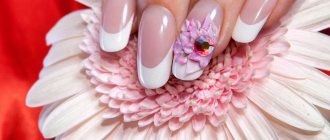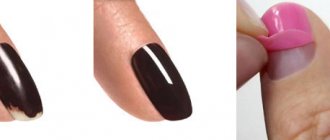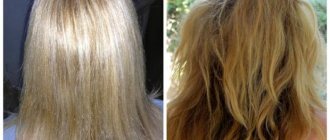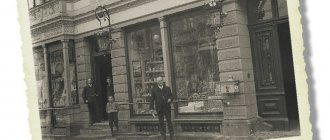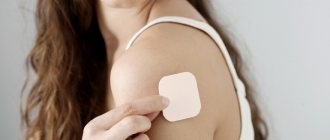About coronavirus
Just because you can get a manicure and pedicure now doesn't mean the pandemic is coming to an end. Quite the contrary: the second wave of “covid” has begun in Europe, one can only guess what it will be like in Russia. However, everyone was tired of both quarantine and the economic crisis: it was vital for beauty salon employees to go to work, many of us really wanted to go to our favorite hairdresser and get ourselves in order. The result: visiting salons has become like a military operation. You can get inside only by appointment at a strictly designated time, everyone’s temperature is measured at the entrance, both the client and the master are wearing masks, equipment and premises are subjected to double processing... Yes, this does not happen everywhere. But it has to be this way to reduce the risk of infection.
In Europe and America, security is monitored much more carefully. Salons even provide gloves with cut off fingers to protect most of the hand from contact with the surface (they are shown in the photo). Try to follow these instructions and demand the same from the salon. After all, only you are responsible for your health.
Avoid your usual cup of coffee or tea in the salon - it’s not a fact that the dishes have been disinfected. The COVID-19 virus lives on surfaces for more than 3 days.
What is it like, a proper “post-quarantine” salon?
Ideally, you should be alone in the salon or in a separate room. If there is no such thing in the salon, a distance of at least 1.5 meters from other visitors must be maintained: you must sit across one table from another visitor. And, of course, remain wearing a mask throughout the entire procedure, just like your master. Yes, it's inconvenient, but it's safe. And if the salon technicians themselves ignore basic safety measures, get up and leave.
The master is required to change gloves and mask after each client - keep an eye on this.
What should a master do?
He must change his gloves to new ones before accepting you. Treat your hands with antiseptic and put on a new mask. Any mask remains safe for two hours, that is, after one session it is no longer suitable. Remember that the virus on various surfaces is active for up to three days - before you sit at the table, the master must wipe the table, chair and everything you can touch with an antiseptic. If he doesn't do this, ask. And, of course, all the instruments he will use must be sterile. Before you sign up for a manicure, find out how and what they process files and scissors in the salon.
Effective European manicure technique
In order to understand how to do a European manicure effectively, you first need to understand that hands are different. Very different. And people are different. A lot depends on your schedule, character and personal preferences. Some people have the opportunity to do moisturizing treatments 2-3 times a day. Some people are very limited in time. Some girls suffer from too dry skin. Some, even with fairly flexible skin and thin, graceful cuticles, still choose edged manicure - because they like it. If you doubt the fairness of this paragraph and think that there is “the one,” universal, best way, just go to any women’s forum thread dedicated to this problem. And you will see that each girl chooses for herself: to doubt, zealously defend her favorite option, blame the master for everything, remain indifferent, complain about her skin, etc.

In principle, an unedged manicure can be done at home, the main thing is to stock up on quality accessories, in particular, a good cuticle remover cream

Don’t forget to nourish your cuticles and nails afterwards. Wax is the ideal solution; it will nourish, moisturize and protect the nail plate

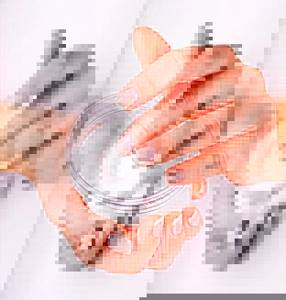
Don't forget about hand cream
In general, performing a European manicure
can be effective and successful if the master knows his hands well. Perhaps you take care of your nails yourself and have decided to switch to the Euro version. Then be patient. The first ten times the result may be disappointing. Here, too, you need to train, understand small features and learn to correct mistakes. Moreover, even an experienced master may need several sessions. Of course, he knows his hands better, his skills are much more active - but great results are obtained only on well-known nails.
On topic: How to properly take a steam bath for a woman
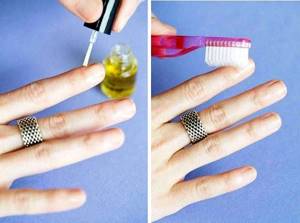
A budget-friendly home method is to apply oil or Vaseline to the cuticles and scrub thoroughly with a toothbrush. With regular use, the cuticle practically stops growing
By the way, regarding whether it is worth doing a European manicure at home, it would not be amiss to once again focus on two important points (we have already written about them above). The first is the correct sequence and speed of work. Some ladies prefer to do manicure intuitively, mixing the stages. And some people like to rush too much or, on the contrary, hesitate, in this case the cuticle may not be moisturized enough or have time to dry out.
Well, if you decide to trust a specialist, demand cleanliness and order. If scissors and tweezers are not used in the process, this does not mean that you can do without thoroughly cleaning the files and cuticle sticks. Make sure that you are using a high-quality gel with a normal shelf life.

Using the unedged technique you can perform not only manicures, but also pedicures.
We sincerely wish you to be patient. European manicure is a wonderful thing. But if your hands are used to cutting, you will need a transition period, up to 10 procedures. Nails and skin need to adapt. The body adapts very quickly. And the trimming method stimulates faster growth, drying and strengthening of the cuticle - in order to effectively “fight the negative effects”. You can’t explain to the body that its functioning is interfered with solely for reasons of beauty and aesthetics. But when the body gets used to the fact that the cuticle remains in place, and even receives nutrients, the European manicure will begin to turn out better and better.
What else can you get infected with?
The most dangerous thing is hepatitis. This virus does not die when it dries out and at an air temperature of about +25°, and is transmitted through both fresh and dried blood. That is, if the master does not use dry heat when processing tools, the likelihood of infection is enormous.
The other two most popular diseases are fungus and warts. The first “lives” on untreated nail files, the second on nail baths.
Try not to go to pedicures where baths are built into the chairs - they are very difficult to rinse thoroughly, and therefore bacteria may remain. Dry hardware pedicure is the safest; any wet treatment is an excellent breeding ground for mycobacterium fortuitum.
Hepatitis does not die in the air and can remain on instruments for about four days.
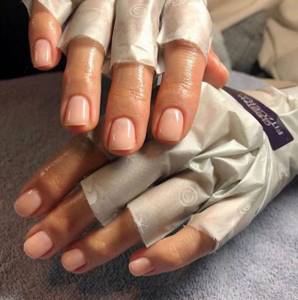
Which manicure is better, hardware or classic: doctors’ opinion
Among specialists there is no clear preference for one type of manicure. The only thing that doctors agree on is that any method of nail care should be carried out exclusively by a professional in compliance with all standards for disinfecting the device or instruments.
Also, according to doctors, self-treatment is allowed, but the devices for carrying out the procedure must belong to one person.
Which manicure is the safest: instrument disinfection
The procedure in which the master complies with sanitary standards will not cause harm. Tool processing occurs in 4 stages:
- disinfection;
- cleaning;
- sterilization;
- storage.
In Europe, they practice a non-edging type of care. The risk of infection is completely eliminated. The chances of getting a disease as a “reward” from the mechanical method of treating nails are minimal. Therefore, classic European or hardware manicures are considered the safest.
Which type of manicure is best for healthy nails?
During a trimmed manicure, there is always a chance of damaging the nail plate or getting injured. Especially if the procedure is performed by an incompetent master or independently. Mechanical should also be carried out by a professional so as not to spoil the surface of the nails.
The most gentle type of processing is the classic European method. Due to its gentle effect on the nail plate and the absence of the need to trim the cuticle.
Is it possible to get hepatitis from a hardware manicure?
Infection with hepatitis after visiting a nail salon is highly likely if the master does not comply with sanitary standards for handling instruments. This is especially true for trimmed manicure. But even with the hardware method, the possibility of catching a virus exists.
Infection of a healthy person can occur after using an untreated instrument containing the blood of someone infected with the virus. Therefore, it is important to visit nail salons that carry out regular disinfection.
Types of tool processing
Many salons work with disposable files and buffs, but replacing all tools with disposable ones is unprofitable. For example, attachments for hardware manicure and pedicure are very expensive.
All stages of processing manicure instruments are indicated in the requirements of SanPiN, and masters must undergo sanitary inspection at least twice a year and receive a mark in the sanitary book - do not hesitate to ask for it before the procedure, it is done for you and your safety. You have the right to do so! Also, do not forget to clarify how and with what tools are sterilized in the salon. There are several of these types, study the intricacies to understand where it is safest.
The sanitary books of the masters are your safety and you have every right to look at them. Don't hesitate to demand.
Hot air treatment
It is also called “sukhozhar”. Devices and instruments are placed in a special oven and heated to 180 degrees Celsius - at this temperature pathogenic flora and all dangerous bacteria die. This is the safest method today. The disadvantage of this treatment is that sterilization takes at least an hour or two, which is not beneficial for small salons near the metro or islets in shopping centers that operate on a regular basis. In a word, the latter do not use it and it is dangerous for your health.
Unscrupulous craftsmen can get tools in craft bags in front of you and even open it in front of you, but this is not a guarantee of safety. How can you tell if your instruments have actually been exposed to dry heat? The sealed kraft bag should be brown in color and have a sterility indicator inside it that changes from blue to yellow after sufficient processing. If there is no indicator or it is blue, you are being deceived.
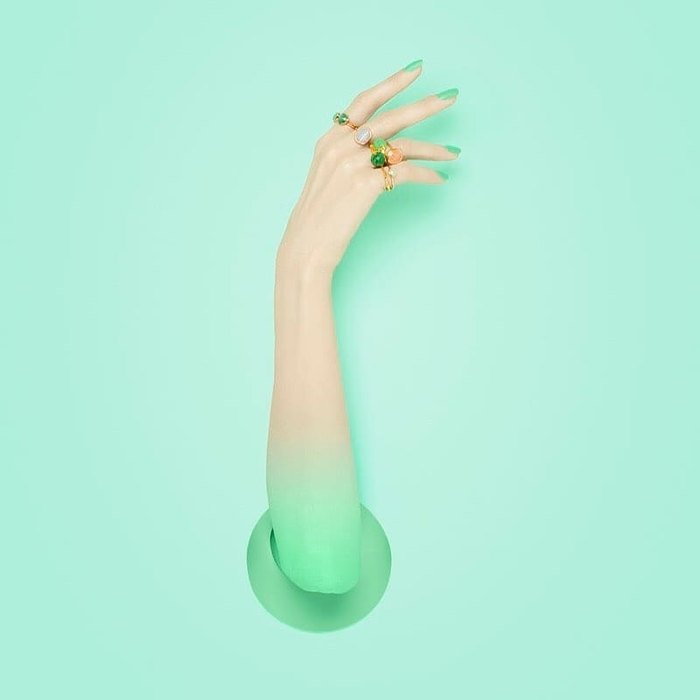
Glasperlene sterilizers
The fastest method of sterilization takes no more than a minute. This is a small glass filled with glassy balls that are heated to a temperature of 230 degrees Celsius. You've definitely seen these containers with white crystals on the masters' tables. The disadvantage of the treatment is that here you can only sterilize solid metal objects, for example, a file, but scissors and wire cutters will no longer work; disinfection of areas with creases and complex parts is impossible. In Russia, treatment with glasperlen is prohibited by Rospotrebnadzor; if you see that a master is using them, should you linger at his table?
Unscrupulous craftsmen place tools in a craft bag without processing and deceive clients.
Ultraviolet sterilization
In some salons, tools are placed in devices that resemble toasters - this is a UV cabinet. The principle of operation is simple: the master places pre-cleaned instruments into the device and they are treated with ultraviolet rays, which should kill bacteria. But customers do not even suspect that the UV cabinet is intended only for processing pre-disinfected, sterilized instruments. This is just maintenance of sterilization, not sterilization.
Ultraviolet treatment is not sterilization, it is just additional protection. It is not safe!
Chemical treatment
And the simplest thing is disinfectants. Masters use alcohol-based sprays and aerosols for sterilization. Yes, formulations with bactericidal and fungicidal components destroy most pathogenic microflora. But can you be sure? that the master processed every millimeter of the instrument? No. The human factor has not been canceled. Chemical treatment is carried out immediately after the procedure only to prepare for further sterilization, for example, in the same dry heat.
Avoid beauty salons that use in-chair foot baths.
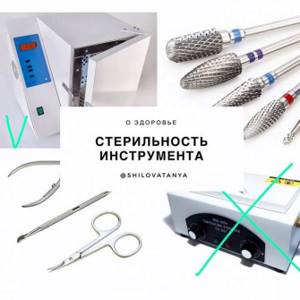
Benefits of hardware manicure
Among the main advantages are the following:
- safety of hardware manicure from cuts and wounds;
- cost-effectiveness (2 procedures per month);
- service speed;
- correction of the nail plate;
- durability of varnish coating;
- hangnails occur less frequently;
- the dry method eliminates the formation of infections.
In addition, manufacturers have developed a device for home use. It does not have such a high speed of revolutions compared to the professional one and is suitable for beginners.
Why are you being lied to?
Masters who can harm you are divided into two types: the first ones do not know that they are harming you, the second ones want to save money. A common case: a master worked in a salon where there was a small dry heater, which was installed by the management of the salon; he believes that this device is safe. Afterwards, the same master begins to work for himself and buys already familiar equipment. He simply does not know that such a tendon does not have a registration certificate and is useless! Only a dry heater with a registration certificate can sterilize.
About those who want to save money. Often the owners of small salons are not manicurists and know little about infections and the dangers of manicure. So, for a manicure island where 10 masters work, a mini-dryer is purchased, in which there is little space and the sterilization tools are stacked on top of each other. The main rule of dry heat is that hot air must circulate! If the instrument is lying on the instrument, it will not become sterile even after 5 hours of treatment.
After proper sterilization, the indicator in the craft bag changes from blue to yellow.
Trim manicure
Pros: the procedure is inexpensive, and if you get a manicure in a salon and the manicurist is a professional, your hands will look well-groomed for more than a week.
Cons: The effect will not last long. The master works with sharp scissors, so there is a risk of cutting himself, which is extremely unpleasant. It is worth checking that all instruments have been disinfected in dry heat. This way you will eliminate the possibility of infection.
Zilya Faizullina, beauty editor : “It’s like I went back a couple of years ago. Again the bath and again the scissors. No, the master did everything perfectly. But considering that I was used to dry hardware manicure, it seemed to me that it lasted a very long time. I also missed my favorite moment, when after the hardware treatment the master paints with a thin brush deep under the cuticle. Here, of course, it won’t work that way. Speaking of coverage. The My Fair Lady salon features the Korean brand Bandi. I've been looking for him for so long! I love it for the huge range of colors, gentle formula and durability.”
How to protect yourself?
Try to go to nail salons that have been in business for many years. Firstly, they value their reputation, and secondly, SanPin has not closed them yet - this is also an indicator.
Pay attention to whether the master throws away the tools after you - if not, then most likely, you also had a manicure done with a nail file from a previous client.
Before a manicure, demand that the craft bag be opened in front of you and be sure to ask to see the notorious indicator. Do not be shy! If the master has everything in order with safety precautions, he will even be pleased to show his professionalism and care for clients.
Another tip is to avoid shaving your legs the day before your pedicure. It sounds strange, but the razor leaves microcuts on the legs, through which bacteria enter the bloodstream - the cause of furunculosis.
You can come to the salon with your own tools - this is the safest thing. Pick them up with your master and always carry them with you. But before each procedure, the master must sterilize them.
Let's check: 10 signs that your nail artist is following safety rules
Today, when more than 113 million photos can be found on Instagram under the hashtag #nails, and salons compete in the elegant execution of minimalistic, but at the same time spectacular nail art, many forget about the most important thing.
Namely: that without key safety rules that every manicurist must follow, nails simply cannot look aesthetically pleasing.
Instagram: @mvk.ua
“I consider it absolute nonsense to popularize aesthetics and focus exclusively on perfectly applied nail designs, while forgetting about the most important thing. Safety is health. This is a priority,” says nail industry expert, technologist and brand ambassador of OPI Ukraine, practicing manicurist with 15 years of experience and founder of the MVK salon Victoria Kolodiy.
Victoria also named ELLE.UA editors nine key signs that your nail artist follows all safety rules:
1. The manicurist’s medical book must be at the workplace and he must provide it at the client’s request.
2. The manicurist must wear gloves and a mask. If a specialist takes care of himself, he will also take care of the client.
3. The specialist must treat the client’s hands with any antiseptic before starting to do the manicure.
4. The specialist must find out what type of manicure the client prefers - classic, hardware, combined. There is no such thing that suits the vast majority, only conventional hardware. It is important to take into account the client’s needs and the characteristics of the skin. Nail technicians are surgeons who intervene in the human body. This should not be forgotten.
5. The instrument with which the master does a manicure must go through all stages of sterilization - disinfection, washing the instrument under running water to remove skin residues and disinfectant, drying, autoclave treatment.
6. Instruments in special craft bags with stickers indicating the date and time of sterilization are opened only in the presence of the client.
7. Instrument hygiene is the competence of an individual person, who in appearance resembles the same surgeon who is set up for a serious operation: a mask on the face, hands must be gloved, replaceable shoes and, of course, shoe covers. For some reason, many are surprised that in a nail salon there is a specialist who is responsible for processing the tool from the initial stage to the final stage. This is the norm and a thorough approach to organizing an important process.
8. There are cases when clients come with their own instrument. As a rule, this happens because they feel safer or have had experience working with irresponsible craftsmen. If a client comes for service with his own tool, of course, the specialist cannot immediately begin work. To protect yourself and continue to guarantee a safe manicure, the specialist must hand over the tool to an assistant for processing - soaking in a disinfectant solution and washing under running water.
9. The client has the right to ask the master to show him how the tool is processed. Clients who come to the MVK workshop for service have the opportunity to see how the sterile workspace is set up, what equipment is used, and how the processing process occurs.
“I am convinced that it does not matter what segment the salon’s target audience covers - premium, average or below average. Every nail salon, which takes a responsible approach to providing nail aesthetics services, does not neglect quality and wants to maintain the client’s trust, will strictly adhere to key safety rules. Because this is a trend that will never go out of style,” adds Victoria.
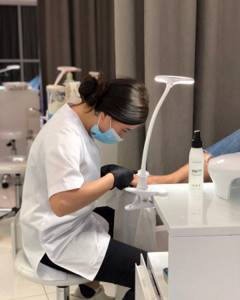
Instagram: @mvk.ua
Types of manicure: how to choose the right one for the client
Very often among masters you can find heated discussions on the topic: which manicure is better. Someone is an adherent of the old school, is used to working with scissors and even looks with disapproval towards the scissors. Some people are in love with hardware manicure and are proud that they do their job with just one cutter.
But let’s look at examples to see how simply providing nail services differs from real craftsmanship.
Every day we see different hands and different problems. And while your client’s main concern is which shade of pink to choose from a huge palette, your task is to determine what problem you are facing and what is the way to solve it. After all, manicurists are not just professionals in masks and gloves, but also kind nail fairies who will always give advice and help your hands look perfect.
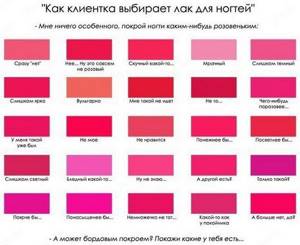
Let's start with the fact that a highly qualified manicurist must master all manicure techniques in order to solve the task assigned to him as quickly and successfully as possible. For example, let's say your client has thin, dry cuticles.
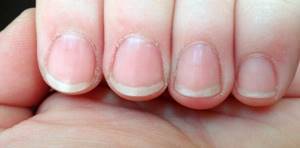
For such hands, a trimmed manicure can be traumatic. As a rule, closely spaced capillaries are the main problem when processing such cuticle. The ideal option is a hardware manicure: the keratinized skin is polished, the manicure is carried out quickly and safely. Such a client can be recommended a course of hot manicure or paraffin therapy in order to restore water balance. A mandatory recommendation is to use rubber gloves when in contact with water and detergents, and apply moisturizer to the skin of your hands. An excellent remedy for solving the problem of dry cuticles is cuticle oil. The drier and thinner the skin, the fattier the oil should be. Ideal - wax butter. It is rubbed into the cuticle and side ridges, moisturizing and massaging the skin. Solid cocoa, shea or coconut butter is an ideal conductor of essential oils, and wax “seals” moisture, leaving the skin feeling moisturized for a long time. Some manufacturers have such oils, but you can easily make it yourself. A small jar of this oil can be offered to the client along with recommended hand care products.
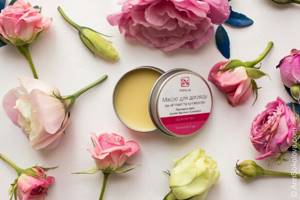
Cuticle wax recipe:
- 1 part beeswax;
- 1 part solid butter of your choice: shea, cocoa, coconut;
- 1 part vegetable oil of your choice: almond, avocado, grape seed, flaxseed, castor, olive;
- 2-3 drops of essential oil of your choice: rosemary (for nail growth), tea tree (antibacterial, antifungal), lemon (strengthening).
First, melt the wax in a water bath, then add solid oils to the melted wax, stir, if necessary, warm up a little so that the mass becomes liquid. After this, add the remaining liquid vegetable oils and essential oils. Mix and pour into jars. After cooling, the oil will become hard, but from the warmth of your fingers it instantly melts and becomes easy to apply.
What type of manicure is best for such hands?
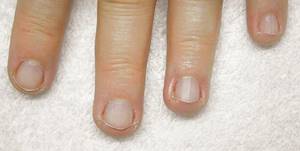
A thin, overgrown cuticle , “creeping” after the nail, can harm the nail plate itself. If the cuticle is not removed in time, then at the junction with the side ridges it begins to crack, and infection can easily get into these cracks. If your client has just such a thin “creeping” cuticle, offer a combined manicure. The device can easily lift the cuticle, clean, sand the side ridges, and carefully cut the cuticle itself with scissors or forceps.
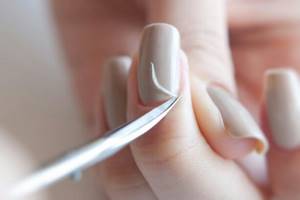
By cutting the cuticle “in one strip,” you ensure proper cuticle growth in the future. The main recommendation for caring for such hands is timely manicure and pushing back the cuticles with an orange stick by the client at home.
If the skin of your hands and nails is very damaged, you cannot do without a trimmed classic manicure.
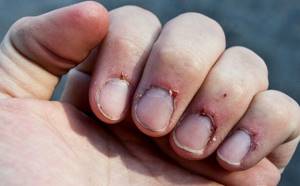
In case of existing inflammation and open wounds, it is best to cut off the burrs rather than grind them with a machine. But you need to be extremely careful so as not to cause harm, and be sure to send your client to a dermatologist so that the doctor can prescribe treatment for the inflammatory process. In this condition, keratolytics cannot be used so as not to injure already inflamed areas. The main task of the master in this case is to remove burrs and clean the side rollers from dirt and dried blood. Treat with an antibacterial agent and send the client to treat the inflammation.
a European manicure , which is not very popular in salons, but is nevertheless very suitable for this type of cuticle .
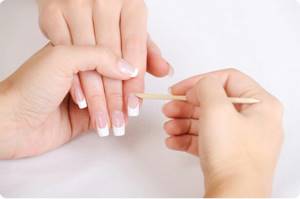
It’s not at all necessary to look for something else to cut off or sand. Ideally, we should all strive to ensure that after the course of procedures you have carried out and the client’s home care recommendations, the condition of the skin of the hands and nails is such that working with them is as easy and quick as possible.
So, let's summarize:
Hardware or combined manicure: an ideal solution for thin, dry cuticles or when the main goal is to slow down the growth of the cuticle.
Trimmed manicure: when your hands are “used,” there are a lot of hangnails, and the large cuticle that has grown on the nail is difficult to move away.
There is a little secret when working with thick elastic cuticle: cut off not all at once, but a third of the total size, in three sessions, leaving a thin strip of a millimeter. This way there will be less stress on the cuticle and it will not grow larger than before. You need to leave a small strip so that with such a structure of the nail it is a necessary protective barrier.
A European manicure takes place if the condition of the hands and nails is close to ideal, the cuticle is alive, elastic and thin, there is no visible damage to the periungual ridges, and manicure is done regularly.
Be professional, look for an individual approach to each client, improve your skills and share interesting cases from your practice in the comments.
Kristina LYSOVA – master of manicure and nail design
Download Premium WordPress Themes Free
Download WordPress Themes Free
Download Premium WordPress Themes Free
Premium WordPress Themes Download
free download udemy paid course
ManicureSelection of manicureNail care
